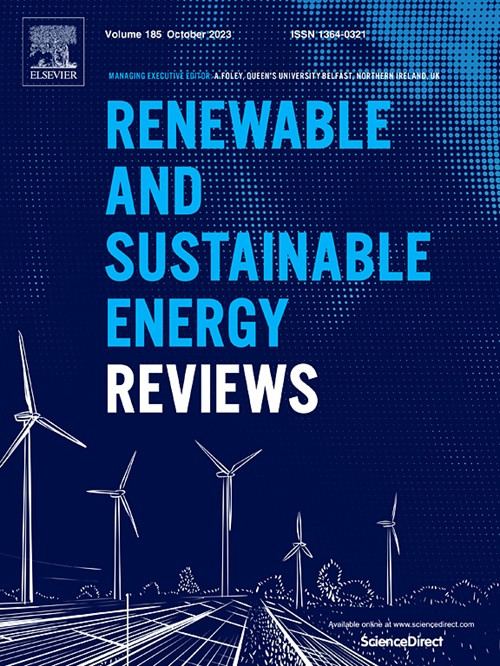采矿和石油行业的岩石水力疲劳方法如何帮助解锁深层热量以实现清洁能源的未来
IF 16.3
1区 工程技术
Q1 ENERGY & FUELS
引用次数: 0
摘要
在自然环境中,岩体受到应力和温度循环的影响,这对岩石的强度和破坏行为有很大的影响。例子包括构造应力变化和地震循环、火山爆发前的地热不稳定、地球潮汐、季节性水波动以及气候变化引起的低频应力和温度循环。地下工程结构,如盐洞、放射性废物处理设施、矿山以及二氧化碳和氢气储存场所,也经历了状态变量的局部循环变化。在本研究中,我们回顾了采矿、石油和地热行业的循环操作过程。我们应用从材料疲劳到岩石力学和地球科学的基本概念和方法,更好地描述和理解实验室和现场循环注入作业中的水力压裂、水力剪切和复杂混合模式压裂。对现有文献的回顾表明,通过循环注入控制水力裂缝涉及以下要素:(a)管理裂缝扩展路径和相关的损伤模式,(b)提高储层渗透率以提高产能或注入能力,(c)减轻诱发地震活动。在能源转型的背景下,岩石水力疲劳的重要性得到强调,因为新兴的可再生能源技术,如增热型地热系统,可以更早、更方便、更有效和更安全地利用,并更好地了解潜在的过程。因此,尽管在很大程度上被忽视,岩石水力疲劳有可能为零排放气候政策目标做出贡献。本文章由计算机程序翻译,如有差异,请以英文原文为准。

How rock hydraulic fatigue methods from mining and petroleum industry assist in unlocking deep heat for a clean energy future
In its natural environment a rock mass is subjected to stress and temperature cycles which significantly affect the rock strength and failure behavior. Examples include tectonic stress variations and earthquake cycles, geothermal unrest before volcanic eruptions, Earth tides, seasonal water fluctuations and low-frequency stress and temperature cycles due to climate change. Underground engineering structures such as salt caverns, radioactive waste disposal facilities, mines, as well as carbon dioxide and hydrogen storage sites also experience local cyclic changes in state variables. In this study we review cyclic operational processes in mining, petroleum and geothermal industries. We apply fundamental concepts and methods from fatigue of materials to rock mechanics and geoscience to better describe and understand hydraulic fracturing, hydraulic shearing and complex mixed-mode fracturing in both laboratory- and field-scale cyclic injection operations. The review of available literature shows that control of hydraulic fractures by cyclic injection involves the following elements: (a) managing the fracture propagation path and associated damage pattern, (b) enhancing reservoir permeability to increase productivity or injectivity, and (c) mitigating induced seismicity. The importance of rock hydraulic fatigue is highlighted in the context of the energy transition, as emerging renewable energy technologies, such as Enhanced Geothermal Systems, can be made available at earlier convenience and more efficient and safer with a better understanding of the underlying processes. Thus, although largely overlooked, rock hydraulic fatigue has the potential to contribute to zero emissions climate policy goals.
求助全文
通过发布文献求助,成功后即可免费获取论文全文。
去求助
来源期刊

Renewable and Sustainable Energy Reviews
工程技术-能源与燃料
CiteScore
31.20
自引率
5.70%
发文量
1055
审稿时长
62 days
期刊介绍:
The mission of Renewable and Sustainable Energy Reviews is to disseminate the most compelling and pertinent critical insights in renewable and sustainable energy, fostering collaboration among the research community, private sector, and policy and decision makers. The journal aims to exchange challenges, solutions, innovative concepts, and technologies, contributing to sustainable development, the transition to a low-carbon future, and the attainment of emissions targets outlined by the United Nations Framework Convention on Climate Change.
Renewable and Sustainable Energy Reviews publishes a diverse range of content, including review papers, original research, case studies, and analyses of new technologies, all featuring a substantial review component such as critique, comparison, or analysis. Introducing a distinctive paper type, Expert Insights, the journal presents commissioned mini-reviews authored by field leaders, addressing topics of significant interest. Case studies undergo consideration only if they showcase the work's applicability to other regions or contribute valuable insights to the broader field of renewable and sustainable energy. Notably, a bibliographic or literature review lacking critical analysis is deemed unsuitable for publication.
 求助内容:
求助内容: 应助结果提醒方式:
应助结果提醒方式:


